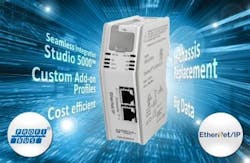New EtherNet/IP to PROFIBUS DP linking device
The EtherNet/IP Linking Devices family already include two Linking Devices which connect devices using serial--Modbus RTU and Modbus-TCP communication. HMS now releases a new Linking Device making it possible to include any automation device with PROFIBUS DP communication into an EtherNet/IP-based network architecture. Besides being a more cost-effective alternative to in-chassis communication modules, says HMS, the Linking Device also brings other advantages:
Improved system architecture--Contrary to an in-chassis module, which is physically connected to the PLC, the EtherNet/IP to PROFIBUS DP Linking Device can be mounted close to the connected devices. This means that it is possible to establish a connection via a single Ethernet cable instead of multiple network specific cables. All EtherNet/IP Linking Devices from HMS support ODVA’s Device Level Ring (DLR) for ring topology.
High performance and stability--The PROFIBUS Linking Device supports up to 7000 bytes of IO data, 3500 in each direction. Since the Linking Device operates stand-alone (distributed), it doesn’t affect PLC backplane performance (PLC execution time), even when large amounts of data are transferred. The PLC simply scans the Linking Device as if it were any other I/O device on the network.






